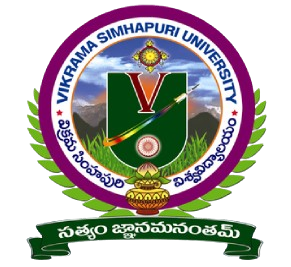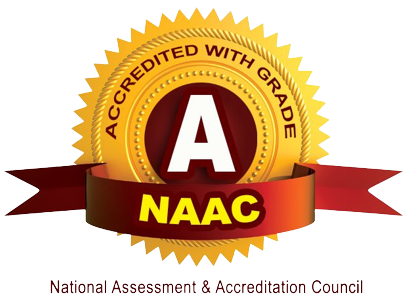|
About R & D
(As per Communication No. 1-5/2021 (NEP/DESK-PARL) dated 14th March 2022 of UGC)
The foundation of a top-notch education is research and innovation. Excellent research at higher education institutions serves as a foundation for excellent education, according to the National Education Policy-2020. Only a dynamic educational system that combines active teaching, in-depth learning, research, innovation, and technological advancement can address societal concerns and help India achieve its goal of being self-sufficient. Universities and HEIs' capacity for research is crucial to providing high-quality instruction.
The Vikrama Simhapuri University's Research and Development Cell supports and promotes a research culture among its faculty and students. The University R&D Cell was established in order to improve the departmental research environment and bring it into compliance with Indian educational regulations. The R&D Cell would foster collaborative efforts between industry and academic institutions, encourage fruitful research, and mobilize funding. The university adheres to the research mission set forth by the different National Missions, SDGs, and Start-Up India, which will result in an Atma-Nirbhar Bharat (Self-Reliant India).
In order to inspire students, scholars, and faculty to actively engage in the process of ideation and innovative research in developing fields, the R&D Cell encourages and supports faculty to conceive ideas through improved industry-academia interactions and prepare research proposals for funding from various agencies. Additionally, it organizes events like capacity-building programs, specific research theme-based workshops, and Research Internships.
In order to create a sustainable research ecosystem, the R&D Cell believes that universities should collaborate with well-known HEIs' RDCs. In order to improve communication between students, scholars, and teachers, universities must develop partnerships, teams/consortia, collaborations, and joint ventures.
The university must establish a centralized Research Information Management System (RIMS) to collect and manage all research-related data, databases, publications, research projects, fellowships, collaborations, patents, etc. A platform for RIMS that allows access to data on human resources, tangible assets, and intellectual capital is also possible. In addition, the university will establish a portal for institutional research information and a repository and enter into an agreement with UGC-INFLIBNET to use Shodh Ganga, Shodh Gangotri, Shodh Sindhu, Shodh Shuddhi, and Shodh Chakra to access and submit research information.
In order to guarantee that academics adhere to ethical standards for research and publication methods at the institutional, national, and international levels, RDC will regularly take action. All papers will undergo a common plagiarism check, and all researchers will have access to the required tools.
For the purpose of capacity building, RDCs will routinely host a range of events, including workshops, forums for group debates, seminars, conferences, refresher courses, training, internships, etc. Additionally, it will enable HEI to raise its accrediting standing, boost its brand image, and win additional research grants under norm-based funding.
RDCs will conduct a quality review (SWOC Analysis) or internal evaluation of research papers and offer suggestions about various UGC recognized journals for paper publication. University must establish and adhere to specific quality benchmarks for research in order to reach global standards. The National Accreditation Board of Laboratories' (NABL) Quality Improvement Program Center and the R & D Cell of HEIs will both work to guarantee that all research labs within the institution adhere toGood Laboratory Practices(GLP) and safety (bio and chemical) standards.
VISION
To establish a reliable system that is in line with NEP-2020's requirements for expanding and bolstering the research ecosystem within University and affiliated colleges.
MISSION
-
To develop a setting that will increase research output.
-
to promote cooperation between business, government, nonprofits, and other organizations on a local, national, and international scale.
-
increasing access to research through the mobilization of finance and resources.
OBJECTIVES
-
To educate faculty members and students about opportunities in research, innovation, and development.
-
To encourage multi- and inter-disciplinary research.
-
To pinpoint each university department's primary topic of research and create relevant frontline teams, cluster groups, and research consortiums.
-
To come up with original concepts and remedies for issues in academia and society.
-
To add new experimental setups, equipment, and technology to the current laboratories so that they can be used for study.
-
To determine the relevant, high-priority research thrust topics that have been made available to researchers from each campus department by various academic, research, business, or government entities.
-
To serve as a point of contact for researchers and pertinent research funding organizations, provide assistance with project proposal writing and submission, and monitor deadline adherence when grants have been sanctioned.
-
To find possible partners from business, academia, research organizations, and other stakeholders for cooperative efforts, synergistic alliances, and the dissemination of research findings.
-
To improve coordination between intellectual property rights (IPR), incubation, innovation and entrepreneurship development, and university-industry interlinkage.
-
To create a system for institutional research information.
-
To facilitate university research by combining several operational units into a single-window system for efficient management.
-
To oversee and manage research progress, manage research resources effectively, and perform timely reviews to assist projects be finished on time.
-
To promote consulting and core competencies.
-
To create, impose, and enforce rules, regulations, and procedures to ensure adherence to the research code and all quality assurance frameworks.
-
To utilize abilities from the community, scientists, experts, and active retirees.
-
To increase public knowledge of filing patents and IPR.
ORGANIZATIONAL STRUCTURE OF R & D CELL
The University must set up a governance committee in order to provide efficient governance as well as functional autonomy, openness, accountability, and adaptability. This group is in charge of ensuring that the Institute's research and development activities are coordinated effectively and smoothly, which promotes overall progress. The advisor, director, and coordinator positions in the organizational hierarchy support the cell's daily operations.
As the supreme body of RDC, there should be a Research Advisory Council presided over by the Hon’ble Vice-Chancellor or his/her designee. The Director (RDC), who would lead several subcommittees to advance governance, shall be chosen from among the esteemed University researchers and nominated by the Hon’ble Vice-Chancellor. RDCs may establish a number of subcommittees to improve their performance.
COMPOSITION OF R & D CELL
Advisory Committee- Institute Research Advisor, Director, Dean, 3 or 5 renowned external Academic Personalities with sufficient Research and Administrative background.
Institute Research Advisor: Hon’ble Vice-Chancellor
Director: The Director nominated by the Vice-Chancellor, will head various Sub-committees to drive the governance.
Coordinators: Teaching faculty members (5-7) from the University, with research supervising experience and non-teaching officers (1-2) representing with experiences in research related administrative duties.
The creation of research models, technology, evaluation, foresightand review functions, mediating sectorial R&D progress, and protecting intellectual property rights are just a few of the many committees that will oversee and mentor all RDC activities. RDC should maintain strong communication with the Innovation Cell in order to utilize a variety of cutting-edge plans for the researchers' convenience.
ROLE OF THE R & D CELL
The Development and Research Cell would offer a setting where researchers could create and disseminate knowledge, innovate, and develop technology for social and industrial requirements using their knowledge and talents, effective governance, and generous financial support.
The University's Research and Development Cell has the following specific duties:
-
To create an annual research plan, carry it out, and keep track of the University Departments' research initiatives.
-
To foster collaboration and networking between University Departments and regional, national, or international research institutions.
-
To create the rules and guidelines for the policy framework for using the resources and facilities of University Departments.
-
Developing policies and guidelines to promote academic departmental student, faculty, and scholar interchange.
-
To develop the university departments' research information management systems and to make it easier for others to access them.
-
To advance the nation's top priorities through a research mandate.
-
To assist university professors in creating research applications for outside financing.
-
To foster national and international funding and the development of research clusters involving university department researchers engaged in highly valuable cross- and multidisciplinary research.
-
To encourage high-quality patents and publications by university department researchers through incentives and rewards.
-
To support the university departments' business-focused infrastructure and technological development.
-
To mobilize the university departments' resources and to raise corpus/seed money from various financing organizations.
-
To find, direct, and encourage investors for the university departments' research and development efforts.
-
To keep an eye on and uphold the moral and ethical standards of university departments' research.
-
To increase the faculty members' and students' ability for research by organizing various research-related activities and events.
-
To create an Industry Advisory Board (IAB) to oversee industrial agreements and collaboration while maximizing the use of consulting services.
-
To build relationships with local and international business and determine the technological difficulties they encounter. In order to expand the range of research alternatives and financing opportunities for teachers and students, it is important to strengthen University-Industry engagement through MOUs for long-term connections with national and international research organizations.
-
To assign teachers and students to address industrial problems so they can conduct research and development (R&D) initiatives to identify solutions.
-
To start and promote MOUs with businesses and R&D institutions for consultancy, teamwork in research, funded initiatives, exchanges between businesses and universities, etc.
-
To assign senior faculty members to different research organizations so they can work on joint projects and adopt best practices.
-
To organize brainstorming sessions through lectures by famous figures from business, R& D enterprises, and reputable institutions in order to better grasp current research methods and methodologies.
-
To alert everyone towards the announcements made by various funding organizations, including DST, DBT, DAE, DRDO, ISRO, CSIR, AICTE, UGC, and universities, among others.
-
To educate scholars about cutting-edge technology through unique lectures on current research issues given by well-known authorities in important fields.
-
To enable prompt auditing and submission of utilization certificate.
-
To acquire information on faculty involvement in mentoring students, paper publications, research projects from outside funding organizations, and participating in collaborative research activities once every three months in the required manner.
-
To plan research-focused activities such as conferences, workshops, seminars, training programs, Avishkar, Science Day, and others.
R & D CELL'S ADDITIONAL RESPONSIBILITIES
-
To encourage faculty members to conduct their own research and collaborate with other groups.
-
To determine the necessary human and physical resources for doing research.
-
To determine the financial needs and available resources for funding the research.
-
To Find out various businesses/industries to work with on joint research projects on current issues of interest.
-
To carefully review research project ideas before sending them to the funding agencies like the UGC, DBT, AICTE, DST, DRDO, etc.
-
To keep track of and evaluate sponsored research project development.
|




